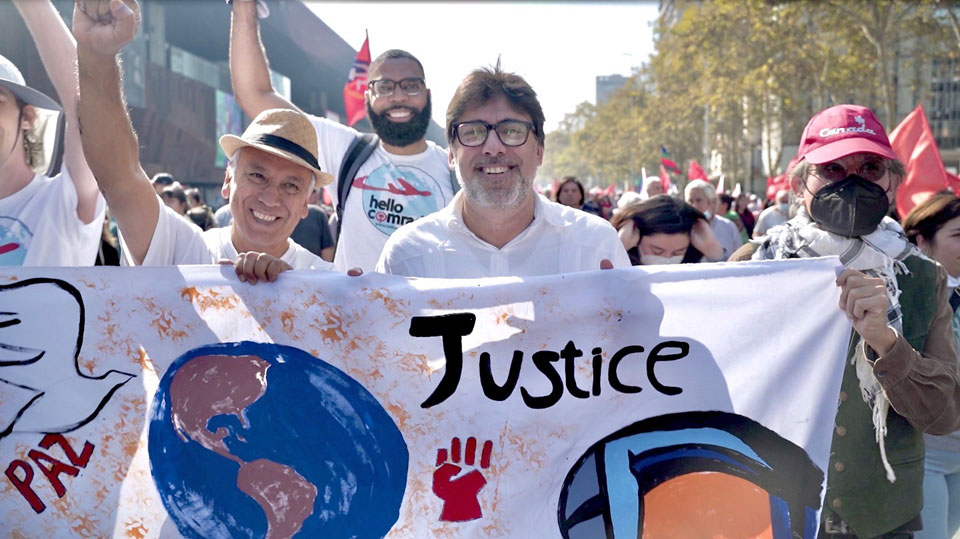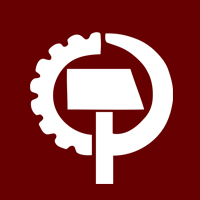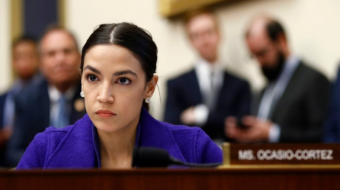
Following is the second article about the recent trip of a group of U.S. communists to Chile, a country where the left is a crucial force in the governance of the country. The group is part of the Hello Comrades project of the CPUSA’s International Commission.
The capital city of Santiago is divided into communes and each one has its own municipal government with a mayor and city council. Within the 32 communes in Santiago Province, four communes have elected mayors from the Communist Party of Chile (PCCh). In north Santiago Province, the commune of Recoleta elected the PCCh member Daniel Jadue to three consecutive terms. Jadue was the party’s presidential candidate for the 2021 elections and was leading nationally in nearly all polls leading up to the election primaries.
The PCCh opted to participate in an optional primary with the other members of their Leftist electoral coalition, and although they were the largest party in the coalition, the other member parties rallied around Gabriel Boric, who ended up winning the primary. The PCCh supported Boric during the general election, and he won the presidency after defeating the right-wing candidate whose family members had ties to Nazi Germany.

The PCCh has several key positions in Boric’s cabinet. The Hello Comrade Project (HCP) visited Recoleta and spent the afternoon meeting with the mayor and touring several of the most ambitious “people’s projects” created in Recoleta during his time as mayor.
Sitting around a long table in the office of the mayor, the HCP team discussed with Jadue his rise in Chilean politics, his understanding of the role of being mayor, the importance of creating tangible social-policy projects that directly improve the lives of the people, and his views on internationalism.
Jadue is a charismatic person and an intellectual thinker and his responses to the group’s questions were both pragmatic and anchored in Marxist theory. Throughout the discussion, he moved easily between the larger ideas that guided his thought and how he applied those ideas to improve the conditions of the working-class residents in his district who had suffered under neo-liberal economic policies for decades. He reminded the group that Lenin wrote that communists running in elections should never chase the vote and instead focus on improving the lives of the people and then the votes will come if you do a good job.
Put theory into practice
The mayor has put his theory into practice with the various people’s projects in Recoleta, including a pharmacy, optical store, book shop, multi-family housing, a free university, and others. Although Jadue was mayor for the creation of the projects, he was very clear that the work was collective and that the local government was guided by community groups and the residents of Recoleta. The projects are so successful because they were conceived from the needs of the people and the municipal government along with the community, were committed to working together to improve the lives of the people. The HCP group was able to tour several of the projects.
The Farmacia Popular: Ricardo Silva Soto is a low-cost pharmacy where Recoleta residents can receive prescription and over-the-counter drugs at up to 80% off retail price. The pharmacy is named after Ricardo Silva Soto who was a pharmacy student killed by the Pinochet dictatorship. The pharmacy is adjacent to the municipal government building and managed by a non-profit corporation assembled by the local government. Because the Pinochet regime outlawed public ownership in Chile, Jadue and his team of attorneys came up with this new type of public corporation to bypass the right-wing legal infrastructure. The pharmacy is able to provide wholesale prices at a retail location because there are few operating costs and the profit margin is topped at the break-even level. Next to the pharmacy, an optical shop provides glasses to the community under the same type of public corporation.

The newest people’s project in Recoleta, the Condominio Justicia Social 1, is a housing project constructed under the same legal framework as the pharmacy but the corporation includes a broader umbrella of projects to improve the lives of the commune. The Innova Recoleta Corporation promotes “innovative projects for community development in social matters, entrepreneurship, housing, education, recycling, among others, focused on the people and neighbors of Recoleta to improve their quality of life.” The five-story building has 38 apartments organized around two wings connected by exterior walkways. The concrete building provides large well-lit apartments with beautiful views of Santiago. Each unit has an exterior balcony and access to a communal outdoor space and playground on the ground floor. Many of the residents are single mothers who were previously in domestic abuse situations and were in desperate need of safe and affordable housing. The monthly rents are not based on market rates, but rather on the tenant’s ability to pay. The rent cannot be more than 25% of income and the average price for each 3-bed/1 bath space is around $100 USD per unit.
Recoleta is also home to the largest cemetery in Santiago and is the final resting place for many of Chile’s most important fighters for the working class. The HCP group toured the National Cemetery and paid respects to those who devoted their lives to the class struggle. We first went to the memorial for the disappeared and murdered from the years of dictatorship. An expansive marble wall roughly 20 feet by 100 feet lists all the names of the victims of the fascist regime. The tragedy of the dictatorship still informs everyday life in Chile as relatives of the deceased were visiting the monument while the group was there and pointed out their family members’ names on the monument to us. In fact, a separate ongoing tomb for the missing is adjacent to the larger monument as remains are still being found around the country, and when found, they are interred in the cemetery.

Not far away, the grave and mausoleum of the late President Salvador Allende rises high above the other monuments. Allende was the President before the coup and was murdered inside the presidential palace by the military. As a member of the Socialist Party of Chile, the Marxist Allende was part of the left coalition “Popular Unity,” that included the PCCh, and was responsible for implementing the nationalization of Chile’s vast natural resources along with other progressive social policies.
The former General Secretary of the PCCh, Gladys Marin, is also interred in the cemetery. Marin was an elected member of the national legislature at the time of the coup and after 8 months in the Dutch embassy, was allowed to leave the country. She snuck back into Chile and was a leader in the clandestine resistance to the Pinochet dictatorship. As part of her funeral, a march through Santiago included up to a million people, demonstrating the important role she played in representing the Chilean working class. She is beloved by the PCCh and the Chilean left and remains an important model of selfless commitment to the cause of socialism.
Another Chilean comrade who lost her life in the class struggle was Ramona Parra. Parra was an activist in Communist Youth of Chile and was killed during a march with the Chilean Confederation of Workers in support of miners rights in 1946. Parra’s sacrifice elevated her symbolic importance within the communist youth and when they formed a mural brigade in support of the Popular Unity campaign to elect Allende for president they named it the “Ramona Para Brigade (BRP).”
In 1969 the first murals were created around Santiago in support of the Allende campaign. The BRP style is clearly within the larger Latin American modern mural tradition of Diego Rivera and David Siquieros, but with a unique Chilean style that incorporates a distinct two-dimensional orientation, the bright colors of Chilean culture, and blending of abstract imagery combining human forms with nature. The BRP murals align with the structure and themes of leftist Chilean poetry and literature with their use of allegory and fantasy to symbolize larger political and social ideas. Although the BRP had to work underground and use paper and wheat paste during the dictatorship, the brigade never stopped its important work. BRP murals are painted all over Santiago and they are an important part of both the artistic and political landscape of the city. The BRP is still a collective within the Communist Youth of Chile (JJCC) and the youth are constantly adding to the vast amount of murals in the city. One of the highlights of the trip for the HCP was helping paint a mural in the center of Santiago on May 1.

One of the founders of the brigade, Alejandro “Mono” Gonzalez, who is known in the BRP as “Monkey,” still paints murals with the brigade and is largely responsible for the BRP style. The HCP met up with him at his gallery, Galeria Taller del Mono, inside a large warehouse repurposed for commercial uses, in a working-class arts district just south of Recoleta. Mono described to the group how the style of the murals originated out of necessity and circumstance rather than a specific art theory. Because the murals were largely painted illegally, finishing the work quickly was extremely important. The BRP style has thick black lines that define the overall form, but also create voids or in-between spaces inside the lines. The voids are easily filled in with one color thereby allowing the team to only need one member who could paint the design, and the rest could just fill in to save time. Mono used the process needed to complete the murals to create a unique and original take on muraling. In order to make the murals into effective vehicles of revolutionary art that could inspire the working class to activism, the complexity of the outlines was increased and the color scheme for the infills became more sophisticated giving the murals a collage feel. The world has taken notice of the art of the BRP and Mono has traveled worldwide talking about their art and painting murals.
He had just finished printing the posters the BRP made for May Day when the group arrived, and they were busy circulating them for distribution and wheat pasting. The poster for International Workers Day 2022 had a grouping of people with flags with each figure being a different color to represent diversity. The Brigada Ramona Para is an important ideological tool for the PCCh and their youth, the JJCC. The murals are everywhere in Santiago and they are impossible not to love. The colorful imagery and poetic scenes of the class struggle are symbolic of the brand of socialism the PCCh, representing the working class, will ultimately bring to Chile.












Comments